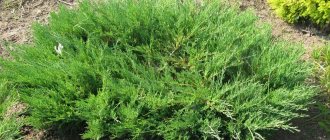Such a herbaceous plant as Phlox is directly related to the blue family (Polemoniaceae). This genus includes approximately 70 species, with approximately 40 species being cultivated. Phlox first began to be grown in European countries in the mid-18th century. Today, thanks to breeders, about 1.5 thousand different varieties of such flowers have appeared. From Greek “phlox” is translated as “flame”. This is how this plant was named by K. Linnaeus in 1737, and that’s all, because in some of the phlox species the flowers have a very rich color. Under natural conditions, such flowers can be found in North America. Due to the fact that the climate of those places is quite harsh, the plant is distinguished by its low maintenance and vitality. And phlox flowers are incredibly fragrant, and the flowering itself is long-lasting.
Features of phlox
Phlox, even of the same species, can differ greatly from each other, and this is influenced by the characteristics of the climate in which the flower grows. So, for example, those plants that grow at an altitude of 4 thousand meters are bryophytes and have a fairly short stature, only 5–25 centimeters. Their branching stems are covered with evergreen leaf blades. If the plant grows in favorable climatic conditions, then it has an erect bush that can reach 30–180 centimeters in height. Subshrubs are also found. These plants also differ in flowering time. So, there are early (spring), middle (summer), and late (summer-autumn). The most common are upright varieties and species. Sessile, entire, oppositely arranged leaves can be elongated-ovate or lanceolate-oval in shape. The diameter of the flowers varies from 2.5 to 4 centimeters. They have a tubular-funnel shape and are part of a complex inflorescence. So, one inflorescence can have up to 90 flowers. The flower consists of 5 stamens, 5 slightly bent petals, and 1 pistil. Most phlox species are perennial plants. However, Drummond phlox (Phlox drummondii) and its various forms and varieties are considered annuals.
The secret to caring for perennial phlox so that they are lush
Bloom
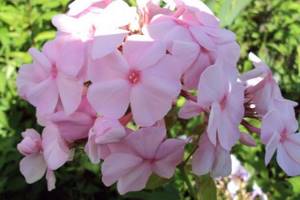
When phloxes bloom, the garden is painted in a sea of various shades - from snow-white to dark purple. You can choose varieties and species in such a way that flowering can last for about six months, starting from May and ending in September.
Flower shape and flowering period
Phlox has tubular flowers that end in a wide funnel that radiates into petals. The flowers are collected in a lush spherical inflorescence, there can be about 60-95 pieces in each.
The duration of flowering varies among different species and varieties; on average, the process lasts from 16 to 28 days.
Main types and varieties
Phlox annuals
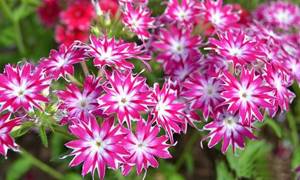
The best annual phlox grown in the garden is Drummonda . The Englishman G. Drummond, who was a naturalist, traveler and theologian, brought it to England from Texas in 1835. In England, this flower has taken root. Flowering for this plant begins in June and ends with the onset of the first frost. The oppositely located leaves have a lanceolate-oval shape. The thin stem is quite branched, and it reaches a height of 20–30 centimeters. The colors of the fragrant flowers are dark red, yellow, purple, white and salmon.

Plants of this species are divided into 2 varieties, namely: large-flowered and star-shaped. The height of Drummond's star (Phlox drummondii cuspidata), as a rule, reaches 30–40 centimeters, but more compact plants (up to 12 centimeters) are also found. The dissected petals give the bright flower a resemblance to a star, in the center of which there is a peephole. Phlox drummondii mixed - its height, as a rule, does not exceed 30 centimeters. Its flowers are quite large in size and can be painted in various colors. But plants with flowers in red shades are more impressive.
Flower growers also divide these plants according to size into dwarf ones, which reach a height of 15 to 20 centimeters, and large-flowered ones. Varieties classified as large-flowered: Tall fiery red, Tall white and Tall bright red. Varieties related to dwarf phlox: Shamoa (pink), Salmona (salmon), Snowball (white), Isabella (yellow) and Defiance (fiery red). All varieties of this type of phlox have both semi-double and double varieties. The most popular are terry flowers of the Promise variety in various colors.
Phlox perennial

The earliest of the types of phlox belonging to perennials is awl-shaped , its flowering begins in May. The plant itself is highly branched and blooms profusely. During flowering, the bush is completely covered with flowers, which can be of various shades from dark red to pure white. The leaves are narrow, awl-shaped, which influenced the name of the variety. This plant is suitable for decorating alpine slides, as well as rockeries.
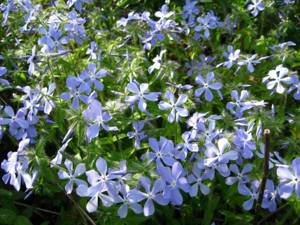
Phlox splayed
Flowering of the splayed also begins in May, but 7–14 days later than the subulate phlox. Compact bushes are decorated with small bluish-lilac flowers. This species loves light less than the previous one, and it also has less dense, but larger foliage and woody shoots.
Phlox paniculata blooms in mid-summer. This species is very popular among gardeners. It has spectacular green leaves and fairly large inflorescences consisting of many fragrant beautiful flowers.

Phlox paniculata
Phlox paniculata - thanks to this species, a large number of very interesting varieties have appeared. Thus, among them, the terry phlox Pure Feelings stands out, in which fairly large inflorescences consist of white flowers, a green stripe runs down the center, and purple flowers are located in the lower part. The elongated petals are slightly curled. The bush can reach a height of 70 to 80 centimeters. Natural Feelings terry phlox also deserves special attention. The inflorescences, similar to the flowering branches of lilac, consist of small greenish-white-pink flowers. Also, thanks to breeders, frost-resistant varieties have appeared, for example, Orange phlox (Orange Perfection, Orange Spat), the flowers of which are painted in various shades of red-orange, which do not fade when exposed to sunlight. They are undemanding, easy to reproduce and have a spectacular appearance. The most popular variety is Phlox King. The bush can reach 100 centimeters in height, the flowers of such a plant are quite large (diameter about 4 centimeters) and can be painted pink, white, crimson, lilac, as well as other color shades.
Popular types, varieties
Phloxes are divided into groups according to their appearance.
Ground cover phlox
They differ from others by creeping shoots that cover large areas when growing. The most famous types are aulate, star, Douglas and snow phlox.
This group blooms earlier than others - already in the month of May.
Loose phlox
A transitional form from carpet flowers to bush flowers, they have low-growing woody branches and rather large leaves. They begin to bloom 8-16 days after the ground cover.
The hardy Canadian (spreading) phlox is commonly grown. When flowering, low lush bushes are covered with many flowers of lilac and blue shades.
Phlox Drummond
Wonderful annual phloxes that actively reproduce by self-sowing. Very durable and undemanding appearance. Blooms from June until frost.
Bush forms
Tall perennial phlox with erect stems. Among them, the most popular are the mountain and spotted species, which bloom from mid-summer.
paniculate phlox
The most spectacular and popular perennial that decorates the garden with round or pyramidal inflorescences that emit a wonderful aroma. Blooms later than other species.
It features a huge range of varieties. Among them, “Aurora”, “Alyonushka”, “Bogatyr”, “Snow White”, “Viking”, “Europe”, “Coral” and many others are very popular.
Growing phlox from seeds
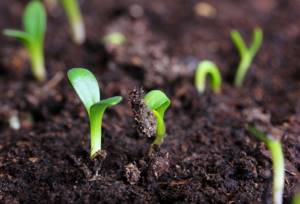
When grown correctly, flowering phlox can decorate your garden from spring until the onset of autumn frosts. The most popular method of propagating such plants is vegetative (by layering, cuttings and dividing the bush). However, some gardeners prefer propagating phlox by seed. Perennial seeds freshly collected in the autumn must be sown in the soil in the winter (in November or December). First you need to decide on the site where these plants will be grown for several years. If snow has already fallen, it should be removed from the garden bed and simply scatter the seeds over the surface of the soil, trying to leave a distance of 4–5 centimeters between the seeds. After this, you need to pour a small (about 1–1.5 centimeters) layer of pre-sifted soil on top of them. And then cover everything with snow again. You can purchase soil in a special store or collect it in advance. Freshly sown seeds have a germination rate of approximately 70 percent. But with the onset of spring it decreases significantly. At the very beginning of spring, phlox shoots will appear in the garden bed. They should be picked only after they have formed 2 pairs of true leaves. The distance between plants should be about 20 centimeters. Planting of such seedlings should be carried out within the prescribed period.
As a rule, phlox, which is an annual plant, is propagated by seeds. To do this, in the spring, you should sow the seeds, leaving a distance of about 3–4 centimeters between them. Then you should water with a sprayer and cover the bed with plastic wrap. You should not sprinkle soil on top of the seeds, but you need to raise the cover for a while every day and remove any condensation that has formed. After the first shoots appear, the shelter should be removed.
How to grow perennial phlox from seeds. Website "Garden World"
How garden phloxes bloom: description, types
Phlox flowers have more than 80 varieties. There are perennial and annual plants. Caring for them is quite simple, but there are nuances and features. The phlox flower loves moisture and frequent watering, but cannot withstand stagnant groundwater near its root system. Also, swampy areas are not suitable for cultivation. They prefer sunny places. With a slightly shaded flowerbed, flowering will not be as abundant as on the sunny side, but longer.
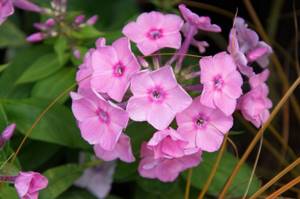
Phlox inflorescence
Planted with bare roots in early spring or autumn. Flowers with a closed root system can be planted throughout the season. You should not place a flower bed with these flowers next to trees or shrubs. The root system of a stronger plant will easily destroy the flowers. You should also remember when weeding that the root system can easily be damaged by weed roots.
Perennial varieties of phlox can be propagated using:
- trunk cuttings;
- root cuttings;
- using seeds;
- dividing the bush;
- germination of buds or shoots.
Important! The characteristics of the variety are transferred to new plants using all methods of propagation, except for sowing seeds.
Most varieties are perennial plants, bushy, creeping or semi-bush, turfy. Bush plants are divided into tall and low growing. The most common and easy to care for are the following types:
- subulate
- ground cover
- Canadian
Subulate variety
A flower brought to Europe and Russia from America. Named subulate because of its pointed leaves. A creeping plant with bright or pale flowers and a delicate aroma. The height does not exceed 25 cm, and the width can grow up to 150 cm.
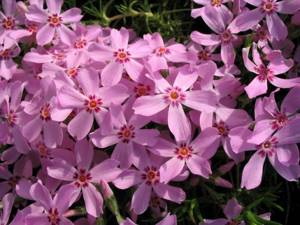
Subulate variety
What awl-shaped phloxes look like: the branches have a flat, five-pointed shape. The diameter, depending on the variety, ranges from 150 to 250 mm. Subulate varieties bloom for up to a month at the beginning of summer.
Important! In warm weather conditions in the first weeks of autumn, reblooming may occur. However, it will not be as abundant and lasting as the first time.
Thanks to its root system and structure, it can grow in soil of only 5 cm. This feature allows the flowers to settle comfortably even in rocky areas. These flowers soften and decorate the stone design of a personal plot or summer cottage.
Flowers of the awl-shaped variety can grow in one place for more than 5 years and quickly occupy all the available space.
Ground cover varieties - flower garden decoration
This is the name given to all types of creeping phlox and some types of loose turf. The name is telling - these flowers cover the entire allocated space with a bright, fluffy and fragrant carpet. At the peak of flowering, only a cloud of color is visible, small leaves are hidden under the blossoming buds.
Non-aggressive and unpretentious plants, with small needle-like leaves, take root well in dry and non-nutritious soils.
They easily relate to close proximity to other plants and flowers, but look best on their own. Ideal for creating all types of design solutions for the garden: flower beds, rock gardens, lawns, flowerpots.
Canadian variety
Phlox canadensis, or splayed, is a perennial plant. Herbaceous, tall: reaches 40-50 cm. The leaves are sharp-oblong, up to 5 cm long. The flowers are flat, star-shaped, the color range is predominantly blue: from white and pale blue to bright blue and bright purple.
Peak flowering occurs at the end of spring - beginning of summer. Duration - 4-5 weeks. Unpretentious, they take root in dry and slightly acidic soils. They grow easily in both sunny and shaded areas.
For reference! To give the flower garden a continuous cover, it is necessary to plant Canadian varieties at a distance of 25-35 cm from each other.
After flowering has finished, the plant needs to be pruned in preparation for the next season.
Other types
Thanks to the work of world breeders, at the beginning of 2021, more than 1.5 thousand different varieties have been bred. Of these, only one species, the Drummond variety, is an annual. The remaining varieties are divided according to the variety of shades, plant height, inflorescences, leaves, and root system.
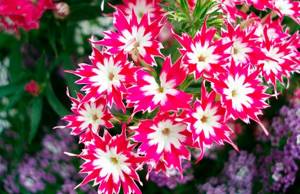
Drummond variety
There are flowers that look like a bouquet - there are up to 50 buds on one stem. There are varieties in which each inflorescence is on a separate shoot. If you combine varieties, you can organize a full-fledged flower garden that will not need additional types of flowers.
Planting and caring for annual phlox
How to plant phlox annuals

Growing such plants from seeds is discussed above. However, there are gardeners who are afraid of night frosts in the spring, which can destroy the plant, so they prefer to grow seedlings at home. Seeds are sown at the beginning of spring (March). The first shoots can be seen just 7 days after sowing. Young plants need to be provided with a sufficient amount of light, watering, and moderate temperature conditions. 14–21 days after emergence, the plants need to be pruned. After the picking is done, it is recommended to shade the phloxes from direct sunlight for several days. They can be covered with newspaper sheets or opaque film. While the seedlings are growing in the house, you can add mineral fertilizers to the soil 2 or 3 times, using ½ of the dose recommended for adult phlox. To make the bush more lush, after 4 or 5 true leaves appear on it, pinch it.

Seedlings are planted in May, leaving a distance of 15 to 20 centimeters between the bushes. To successfully grow phlox, you need to choose a suitable place. Annual phloxes are not afraid of cold and drought, they love light, but react negatively to overheating of the roots. The most spectacular plants grow in partial shade. It has been noticed that the more the area is shaded, the longer the plant will bloom, but at the same time fewer flowers will grow on it. It should be noted that most varieties fade in the sun during the flowering period. But this does not threaten plants in partial shade. The color of their flowers remains rich for a long time. Particularly beautiful are the “blue” varieties growing in a shaded place, the flowers of which become almost blue in poor light. To plant phlox, it is recommended to use high beds, next to which there are no bushes or trees with a fairly extensive root system.
Such a plant needs soil that contains a lot of humus. Please note that the plant may die in heavy soil with poor drainage. If you have chosen an area with acidified soil for planting, then you must add lime to it. The most suitable for growing such flowers is fertile sand, which does not contain clay. If you water the plants planted in it well, they will grow powerful and beautiful. Before planting phlox in heavy loam, it is necessary to add organic fertilizers, sand, and peat. Prepare a not very deep hole for the plant and be sure to pour compost, vermicompost or 2 handfuls of wood ash into it. The roots should be spread horizontally.
Caring for annual phlox

Growing annual phlox is not difficult. So, they need to carefully loosen the top layer of soil 6-8 times per season; in the second half of the period of intensive growth, they need to hill up the plant during loosening, for better and faster formation of the root system. Organic and mineral fertilizers should also be added to the soil. In the last days of May, you need to feed the phloxes with liquid manure for the first time (25 g of the substance is taken per 10 liters of water). The second feeding is carried out in the first days of June, but at the same time superphosphate or potassium salt must be added to the prepared liquid manure. In the first days of July, liquid manure (without additives) should be added to the soil for the third time. In the last days of July, you should feed the plant 4 times, and the fertilizer should contain potassium salt and phosphorus.
How to water correctly

Plants should be provided with systematic moderate watering in the morning or evening. When watering, water should be poured at the root, and 15–20 liters of water should be used per 1 square meter. If you water phloxes with cold water on a hot day, this can lead to cracking of their shoots. It is recommended to pick off wilted flowers, because they interfere with those that have not yet bloomed.
Diseases

Phlox can develop variegation. In this case, a pattern unusual for this plant appears on the surface of the leaves and flowers, which significantly worsens the decorative qualities of the flower. A diseased plant cannot be cured, so it must be dug up and destroyed. If phloxes become infected with powdery mildew, they will also need to be destroyed. You can tell that a flower is sick by the matte white coating that appears on the foliage and shoots.
Such a plant can also become ill with formosa, in which case the leaves dry out and the stems become brittle. For preventive purposes, it is necessary to treat foliage and shoots with colloidal sulfur. It should be taken into account that during processing the air temperature should be above 18 degrees, and the substance should not be allowed to come into contact with the inflorescences. When infected with septoria, dark brown dots form on the surface of the foliage. As the disease progresses, they increase in size. The diseased plant must be treated with Bordeaux mixture, as well as the surface of the soil near it. After half a month, repeated treatment is carried out. Verticillium wilt has a detrimental effect on the plant's root system, but only those phloxes that grow in acidic soil are susceptible to this disease.
Phloxes. Diseases and treatment.
Pests

A nematode (a very small thread-like worm) can settle on the plant and suck the juice out of it. A sign that phlox has such a pest are disfigured inflorescences, crushed flowers and thinned shoots. The infected plant is dug up and destroyed (burned). The soil must be treated 3 times with nematicides, and an interval between treatments should be maintained at 3 weeks.
Naked slugs can eat leaves, flowers and even the lower part of shoots at night. Systematic loosening of the soil and weeding is an excellent preventive measure against slugs. In case of severe infection, it is recommended to sprinkle the soil surface with wood ash, fluff lime or tobacco dust mixed with ash. Any butterfly caterpillars on the foliage can be removed manually. In case of severe infestation, plants are treated against leaf-eating pests.
First steps after purchase
On sale you can find both already flowering Phlox and specially packaged rhizomes with small shoots. Depending on the stage of growth at which the plant was acquired, the steps taken to arrange it will vary.
If you buy a rhizome, remove it from the bag, carefully straighten the roots and plant it in a pot, being careful not to damage the small sprouts. Phlox is very often affected by powdery mildew and, for the purpose of prevention, it is treated several times a season with Bordeaux mixture or special preparations. The first treatment is carried out after the appearance of sprouts of 10–15 cm.
If an already blooming Phlox appears in the house, its foliage should also be treated, making sure that the drug does not get on the inflorescences. If the plant is in transport soil, it should be transplanted into medium-density nutrient soil. Even flowering specimens can easily be moved to another container.
For planting, choose a pot no deeper than 25–30 cm and the same diameter. Drainage should be good, and the soil in the pot should not dry out. Also, do not neglect loosening the soil in the pot, this will improve the aeration of the roots.
Sometimes in a new environment the plant drops its leaves. To facilitate acclimatization, it is worth covering it for several days with a plastic bag with small holes. This will create increased humidity and allow it to recover. If this does not help, you should cut off the inflorescences and cover the plant again. It will be easier for him, and in a few weeks new shoots and inflorescences will appear.
Planting and caring for annual phlox
Planting perennial phlox

Planting such phloxes is very similar to that used for annuals. However, when planting plants in the spring, it will be necessary to pour a layer of mulch (humus or dry peat) onto the soil surface. The distance between the bushes should be left quite large (about 50 centimeters), since in a few years they will grow quite strongly. When purchasing seedlings of such flowers in the autumn, they should not be planted in open ground. It is recommended to bury the seedlings to a depth of 20 to 25 centimeters, choosing for this an area protected from gusts of wind; it should also retain snow in the winter. After the soil freezes, cover the plants with dry leaves or peat.
Sometimes it is possible to plant perennial phlox in open ground in the fall. A bush that has grown and lost its beauty can be divided in the autumn (from mid-August to mid-September). For planting, the side divisions are used, and the central part is thrown away. In autumn, phloxes that were planted in the spring from cuttings are also transplanted to a permanent place.
During autumn planting, compost should be added to the soil, peat should be added to sandy soil, and sand should be added to clayey soil. The holes are placed at a distance of 50 centimeters from each other. The divisions are lowered into them and the roots are straightened horizontally; they should be dug shallow (about 4–5 centimeters). In dry weather, watering is carried out every 2–3 days (within 14 days). Take 2 liters of water per bush. The dried surface of the soil must be loosened and sprinkled with a four-centimeter layer of mulch (humus or peat).
Care

Care rules are similar to those used for annuals. But such plants need to be fed 5 times per season, with the last time fertilizers being applied to the soil during seed formation. For feeding, a solution consisting of 5 liters of water, 10 g of superphosphate and 5 g of potassium sulfate is used. You need to feed in the evening after watering, but do not allow the solution to get on the foliage. If you care for the plants correctly, they can be grown in one area for 7 years.
Cuttings of these plants can be carried out during the entire period of intensive growth. The cuttings begin at the time when the stem reaches a height of 5 centimeters, and the end occurs in the last days of September. Cuttings taken from the plant in spring and summer take root best. The plant can also be propagated by layering. Before the plant blooms, its shoot is bent to the surface of the soil, fixed along its entire length and covered with a mixture of peat and humus. In autumn, a young plant is separated from the mother bush and planted in a permanent place.
Planting phlox in the ground
When planting phloxes, take into account the characteristics of their root system. It is located mainly in the upper layer of soil and consists of many thin processes. The root mass does not tolerate competition from stronger plants (shrubs and trees) and stagnation of water in the surface layer of the earth.
Planting methods
- Seating
Seedlings are planted in pre-prepared holes, removed from a temporary container.
IMPORTANT! If you overdry the rhizome when planting, the phlox will hurt, acclimatize and develop poorly.
Before planting a bush, the planting hole must be filled with water and wait until it is absorbed. The base of the seedling is buried to a distance of at least 2.5 cm. Rooting occurs within 13-16 days.
The distance between plants is maintained from 35-45 cm, between rows from 50 cm.
- Growing phlox from seeds.
Planting material can be planted directly in open ground in spring or autumn. Seeds of some types require stratification, others can be sown without preparation. Typically these include annual varieties. Perennials are planted as seedlings or in the soil before winter. It is recommended to buy hybrid seeds in a store to get exactly the plant you want. Otherwise, independently prepared material will not receive varietal characteristics of the flower.
Before sowing, the seeds are freed from the capsules to increase germination. Soaking in a container of water will help select high-quality seeds - only those that have settled at the bottom can be planted. Those that pop up are empty and useless.
Optimal time for planting
Planting and replanting phloxes is allowed all summer, including autumn September. You can start planting as early as April, after the soil has thawed and warmed up slightly. Before winter, seeds are sown until the November frosts.
Soil for the plant
Phloxes are little picky about the composition of the soil, being content with any. However, loam is ideal - moderately loose and moist, containing useful elements and a neutral reaction.
ADVICE! Add an organic component (compost or rotted mullein) and wood ash to the planting soil. Grateful flowers will grow powerful and bloom luxuriantly.
Planting phlox in autumn
Seedlings can be planted in the first autumn month. To do this, the flowering top must be cut off and the leaves and stems left. Phlox planted in the fall will bloom next summer.
Planting material purchased later should not be planted. Usually the sprouts are buried in a quiet place 1-2 inches deep, covered with lutrasil or a layer of mulch on top.
Planting in spring
It is advisable to plant phlox seedlings before mid-May so that they take root before the summer heat sets in.
Features of care after flowering and in winter

Annuals can grow in the spring of next year, but their decorative qualities will be low. Having collected the ripened seeds in the autumn, remove the remains of the plants and dig up the soil, removing the remaining rhizomes.
During the snowless winter period, the growth buds of phlox will most likely freeze out at temperatures of about minus 10–15 degrees. If it is colder than 20–25 degrees, this will lead to the death of the root system. In this regard, in autumn, the dried upper part of the plant must be removed, and the root collars must be covered with a layer of soil mixed with peat. They should be covered with dried leaves, straw or spruce branches on top. With a snow cover of 50-60 centimeters, phloxes can easily withstand thirty-degree frosts.
Pruning phlox
Secrets of success
Phlox is a very unpretentious, easy to grow and rewarding plant. When well grown, Phlox is a very unpretentious, easy to grow and rewarding plant. With good care it is very resistant to pests and diseases. Feels good both on the sunny side and in partial shade. During flowering, the pot can be placed on a table or bedside table. The plant will not suffer from lack of light, will decorate any interior and fill the house with an amazing aroma. Later, the inflorescence is cut off and Phlox is returned to a sunny windowsill, balcony or terrace to plant new buds. If the inflorescence is not cut off after wilting, flowering will not resume, but the seeds will ripen and spread by self-sowing.
The plant needs very nutritious soil, regular watering and fertilizing. This will provide it with long and abundant flowering over a long period. Feedings are alternated weekly with complete mineral fertilizers with a high nitrogen content and organic fertilizers.










